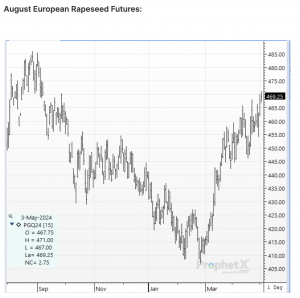- HEADLINES: Wheat sags on profit taking; GFS weather forecast features soaking Midwest rain; CONAB raises Brazilian corn, soy crops slightly.
- Chicago ag markets at midday are lower by varying degrees. Wheat futures in the US and Paris are down sharply on profit taking, July Chicago wheat’s RSI on Monday hit 76, and following the $1.40 rally in Chicago and €47/mt rally in Europe, a correction is needed. The very early stages of this week’s tour of the KS wheat crop is featuring solid yield potential in the east/northeast part of the state, and not until the tour travels westward will drought damage be assessed. Markets broadly are lacking new bullish enthusiasm.
- Yet, it feels that weakness in corn and wheat will be confined to profit taking corrections. US exporters sold 405,000 mt of corn to Mexico for old and new crop delivery. Climate forecasts are unchanged, with too much rain forecast in the Midwest US and France, and little/no rain offered to most of the Black Sea into late May. Volatility is the theme, but grains have a story in declining non-US production numbers.
- CONAB is unwavering in keeping Brazilian corn and soy estimates well below USDA forecasts. CONAB this morning estimated total Brazilian corn production at 111.6 million mt, vs. 111.0 million in April. Safrinha harvested area was raised 200,000 hectares, while projected yield loss in Mato Grosso do Sul and Parana more than offset a 1% hike in Mato Grosso’s yield. Recall USDA in its May report pegged old crop Brazilian corn production at 122 million mt. Unfortunately, clarity is unlikely to emerge until bulk yield data is available in July, but most probably CONAB raises its forecast a bit while USDA lowers theirs.
- CONAB raised 2023/24 Brazilian soybean production to 147.7 million mt, vs. 146.5 million in April. Acreage hikes in central and northern states more than offset lower projected yield in Rio Grande do Sul in the far south. USDA estimates Brazilian soy production at 154 million mt. Large production discrepancies between S American agencies and USDA persist. Brazilian soy fob premiums are steady to slightly higher this week, but a meaningful shift in world demand from S America to the US is unlikely until September.
- Also of note, CONAB trimmed its 2024 Brazilian wheat production estimate to 9.1 million mt, vs. USDA’s 9.5 million. On balance, this adds 400-500,000 mt to Brazilian net wheat imports in 2024/25. 40% of Brazil’s wheat crop is grown in Rio Grande do Sul and is planted in June. Model guidance stays wet in RGDS into final days of May. Drier weather will be needed for timely wheat seeding there.
- The midday GFS weather forecast is wetter in the E Plains and E Midwest in the 6–10-day period. The model is struggling with exact totals/coverage, and confidence in forecast details isn’t overly high. However, it is still a wet forecast and E OK, E KS, TN, KY and the Southern Midwest are favoured with 10-day precipitation accumulation of 3-5+”. NOAA has issued an alert pertaining to the risk of excessive rainfall across the W Plains/SW Midwest in the 8–14-day period. Better windows for planting open across the N Plains and IA moving forward.
- The spec community is booking profits in wheat, while CONAB’s influence on corn and soy price discovery has waned. It is S American corn yield data this summer that determines the degree of tightening in the world and exporter corn balance sheet. Upside risk remains present in corn and wheat, we are concerned about nearby soy export demand.

